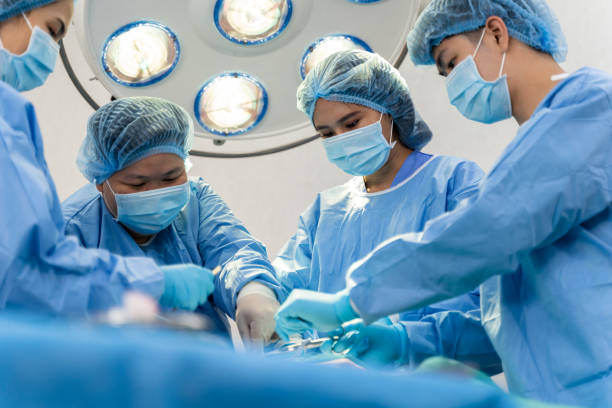Oophorectomy, often referred to as ovary removal surgery, is a medical procedure where one or both ovaries are surgically removed. This procedure is typically performed to treat various gynecological conditions and reproductive cancers.
Why Oophorectomy
There are various reasons why your doctor might recommend this surgery:
- Benign Tumors: Noncancerous growths in the ovaries.
- BRCA Gene Mutations: Genetic changes that increase the risk of breast or ovarian cancer.
- Cysts: Noncancerous fluid-filled sacs.
- Ectopic Pregnancy: Pregnancy occurring outside the uterus, often in the fallopian tubes.
- Endometriosis: Abnormal growth of uterine tissue outside the uterus.
- Ovarian Cancer: Cancer originating in the ovaries.
- Pelvic Inflammatory Disease (PID): Infection in or around the ovaries.
- Ovarian Torsion: Twisting of the ovary, potentially causing severe pain.
- Pelvic Pain: Relief of chronic pelvic pain or pain following a hysterectomy where the ovaries are preserved.
Prevalence
- Oophorectomy is a common surgical procedure, especially among women diagnosed with ovarian cancer or those at high risk of developing it due to genetic factors.
- According to the American Cancer Society, approximately 21,410 new cases of ovarian cancer are diagnosed each year in the United States, making it the fifth most common cancer among women.
Types of Oophorectomy
There are various types of oophorectomies, each tailored to address specific medical conditions:
- Unilateral Oophorectomy: Removal of one ovary.
- Bilateral Oophorectomy: Removal of both ovaries.
- Salpingo-oophorectomy: Removal of an ovary and its accompanying fallopian tube.
- Bilateral Salpingo-oophorectomy: Removal of both ovaries and fallopian tubes.
- Hysterectomy with Salpingo-oophorectomy: Removal of the uterus along with one or both ovaries and fallopian tubes.
Oophorectomy Procedure
The procedure is typically performed under general anesthesia, rendering the patient unconscious. However, in certain cases, local anesthesia may be utilized, numbing only the area of operation.
Different surgical approaches may be employed based on individual circumstances:
- Open Procedure: The traditional method involving a single large incision in the abdomen. This allows the surgeon to visualize and remove the ovaries after separating them from surrounding tissues and blood vessels.
- Laparoscopic Surgery: Utilizes a small camera (laparoscope) inserted through a tiny incision in the bellybutton. Additional small incisions are made as needed for surgical tools, with the ovaries removed through these openings or the vagina. In some cases, this approach may transition to an open procedure mid-operation.
- Vaginal Approach: Typically combined with a hysterectomy, this method involves a lower risk of infection and potentially quicker recovery.
- Laparotomy: Involves a larger abdominal incision for ovary removal. Although less common, it may be necessary in certain situations.
- Robotic-assisted Ovary Removal: Involves several small incisions for the insertion of a robotic camera and specialized instruments. The surgeon controls the robotic device guided by the camera, facilitating precise ovary removal.
Your doctor will recommend the most suitable approach based on your medical condition and individual needs.
Recovery
Hospital Stay:
- After an open oophorectomy, anticipate a hospital stay of several days. However, with laparoscopic or robot-assisted procedures, you may either be discharged on the same day or stay for just one night.
Recovery at Home:
- Follow your doctor’s instructions diligently for a smooth recovery:
- Keep the incision site clean and sterile.
- Maintain a healthy diet.
- Avoid driving, heavy lifting, and strenuous exercise.
- Take prescribed pain medication.
Return to Normal Activities:
- Your ability to resume normal activities hinges on various factors, including your pre-surgery health and the surgical approach. Most women regain their active lifestyle within six weeks post-surgery. Those undergoing laparoscopic or robot-assisted surgery typically recover faster, often within two weeks.
Warning Signs:
- While recuperating, be vigilant for indicators that necessitate medical attention:
- Bleeding or discharge from the incision site.
- Nausea, vomiting, or fever exceeding 100.4°F.
- Difficulty urinating.
- Severe pain or swelling/redness around the incision.
- Unusual vaginal discharge accompanied by itching or a foul odor.
Potential Risks of Oophorectomy
While oophorectomy is generally considered safe, like any surgical procedure, it carries certain risks:
- Bleeding: Excessive bleeding during surgery may necessitate blood transfusions.
- Organ Damage: There’s a slight risk of bladder or bowel damage during surgery, though it’s rare, occurring in less than 1% of cases.
- Infection: Infections may develop post-surgery, presenting symptoms such as fever, redness, and pain near the incision site.
- Hernia: Weakness in the muscle near the incision site may lead to hernias.
- Tumor Rupture: Tumors could rupture during surgery, potentially spreading cancerous cells.
- Retention of Ovary Cells: Residual ovary cells may persist, causing pelvic pain or other issues.
- Loss of Fertility: Removal of both ovaries necessitates fertility treatments like in vitro fertilization (IVF) for pregnancy.
Your doctor will thoroughly discuss these risks with you before the surgery. Their recommendation for the procedure indicates that they believe the benefits outweigh the potential risks for your specific situation.
Oophorectomy Impact on Fertility and Menopause
Following oophorectomy, women may experience symptoms resembling those of menopause, including hot flashes, vaginal dryness, and an increased risk of osteoporosis, anxiety, depression, heart disease, memory problems, and decreased libido. To manage these symptoms, your doctor may suggest low-dose hormone therapy, medications, and lifestyle adjustments.
Concerns about fertility are common, particularly among younger women. Whether pregnancy is still possible post-surgery depends on individual circumstances. If only one ovary is removed, the remaining ovary typically continues to produce estrogen, allowing for menstrual cycles and potential pregnancy. However, if both ovaries are removed, fertility may be compromised, necessitating treatments like in vitro fertilization (IVF). In some cases, eggs can be harvested and frozen before surgery for future use. It’s essential to discuss your fertility options with your doctor to make informed decisions about your reproductive health.
- Following surgery, it’s essential to follow the post-operative care instructions provided by your healthcare provider.
- Rest and avoid strenuous activities during the initial recovery period.
- Attend follow-up appointments as scheduled to monitor healing and address any concerns.
Sources
- American Cancer Society. (2022).
- Mayo Clinic. (2022). Oophorectomy.
- Women’s Health.
- University of Michigan.
- Facing Our Risk of Cancer Empowered (FORCE)
- National Cancer Institute
- UpToDate
- Memorial Sloan Kettering Cancer Center
- New York University School of Medicine.
- Cleveland Clinic
- Breastcancer.org

